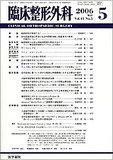Japanese
English
- 有料閲覧
- Abstract 文献概要
- 1ページ目 Look Inside
- 参考文献 Reference
肩関節の自動挙上が不可能な腱板断裂の症例(10例10肩)に対してmini-open cuff repair法(mini-open法)を行った.これらの症例の術後2年の時点での治療成績を検討した.JOAスコアの機能項目では,広範囲断裂群は大断裂群と比較して評価点が有意に低かった.また,広範囲断裂群は大断裂群と比較して術後の屈曲と外転角度が有意に小さかった.Mini-open法は,大断裂に対して有効な治療手段と考えられる.しかし,広範囲断裂群では,術後の自動屈曲・外転角度の改善が大断裂群に比し不良で,機能項目の評価点が低く,治療成績は劣っていた.
The purpose of this study was to evaluate the outcome of a mini-open cuff repair for a full-thickness rotator cuff tear with difficulty in active elevation of the shoulder. Ten shoulders in 10 patients who had undergone a mini-open cuff repair for rotator cuff tear were studied. Postoperative results were evaluated using the JOA score, range of motion, and visual analog pain scale (VAS) at two year after surgery. The JOA score for function in the massive tear group was lower than that in the large tear group. The massive tear group demonstrated significantly less active flexion and abduction of the shoulder postoperatively than the large tear group. No significant difference was found between the large tear group and the massive tear group in the VAS results. The mini-open cuff repair is an effective procedure for large tears. However, the outcome in the massive tear group was worse than that in the large tear group.

Copyright © 2006, Igaku-Shoin Ltd. All rights reserved.


